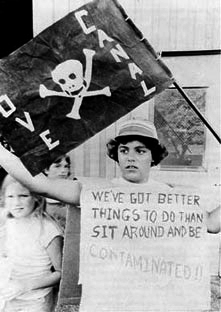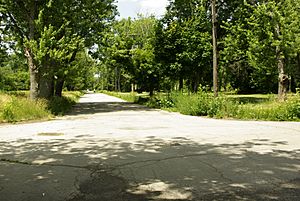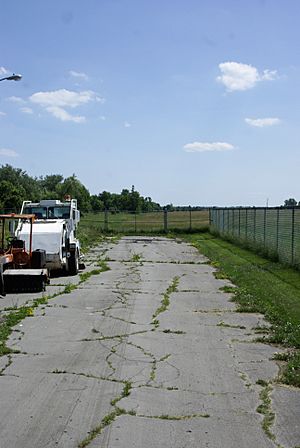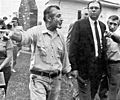Love Canal facts for kids
Quick facts for kids Love Canal |
|
|---|---|
| Superfund site | |

Love Canal in 2012
|
|
| Geography | |
| City | Niagara Falls |
| County | Niagara County |
| State | New York |
| Coordinates | 43°04′50″N 78°56′56″W / 43.080518°N 78.948956°W |
| Information | |
| CERCLIS ID | NYD000606947 |
| Contaminants | Various chemicals |
| Responsible parties |
Hooker Chemical Company |
| Progress | |
| Proposed | December 30, 1983 |
| Listed | September 8, 1984 |
| Construction completed |
September 29, 1998 |
| Deleted | September 30, 2004 |
| List of Superfund sites | |
Love Canal is a neighborhood in Niagara Falls, New York, USA. It became famous in 1977 because of a serious environmental disaster. For many years, a large landfill in the area was used to dump toxic chemicals. These chemicals later leaked, causing severe health problems for hundreds of people living nearby. The area was cleaned up over 21 years through a special government program called Superfund.
Love Canal was first planned in 1890 as a perfect community, but it was never fully built. In 1894, work started on a canal to connect Lake Erie and Lake Ontario, but it was stopped after only about 1 mile (1.6 km) was dug. By the 1920s, this unfinished canal became a dump for city trash. In the 1940s, the Hooker Chemical Company bought the canal. They used it to dump about 19,800 tons (18,000 metric tons) of chemical waste from making dyes, perfumes, and plastics.
In 1953, Hooker Chemical sold Love Canal to the local school district for just $1. This happened after the school district threatened to take the land. Over the next 30 years, the toxic waste buried there caused major health problems. Many families had to leave their homes. People suffered from long-term health issues, including high white blood cell counts and leukemia. Because of this disaster, the US government created the Superfund law to clean up dangerous waste sites. The cleanup of Love Canal involved tearing down many homes and finished in 2004.
In 1988, New York State Health Commissioner David Axelrod said Love Canal was a "national symbol" of failing to care for future generations. It was a unique situation where people ended up living right next to dangerous waste. The University at Buffalo has many old documents and photos about the Love Canal disaster.
Contents
- Where is Love Canal?
- Early History of the Canal
- Hooker Chemical Company's Use of the Canal (1940s–1952)
- Selling the Land: A Risky Deal (1952)
- Building Schools and Homes (1952–1957)
- Discovery of the Problem (1970s)
- Raising Awareness and Taking Action
- Community Action and Activism
- Government Steps In (1978–2004)
- What Happened After the Cleanup?
- Other Contamination: Wheatfield Landfill
- Images for kids
Where is Love Canal?
Love Canal is a neighborhood in Niagara Falls, located in the northwest part of New York state. It covers 36 blocks in the city's far southeastern corner. The neighborhood stretches from 93rd Street on the west to 100th Street on the east. Bergholtz Creek forms its northern border, and the Niagara River is about 0.25 miles (0.4 km) to the south. The LaSalle Expressway cuts through the southern part of the area. The original canal itself covers about 16 acres (6.5 hectares) in the central eastern part of the neighborhood.
Early History of the Canal
A Dream That Didn't Happen (1894–1940)
In 1890, a lawyer named William T. Love planned to build a perfect city with parks and homes near Lake Ontario. He wanted to use a canal to provide electricity from Niagara Falls for new factories. He called his project Model City, New York.
By 1892, Love's plan included a shipping canal to bypass Niagara Falls, making it easier to transport goods between Lake Erie and Lake Ontario. He got money from banks in New York City, Chicago, and England. In October 1893, the first factory opened. Work on the canal began in May 1894. Steel companies and other businesses were interested in building plants along Love Canal. Love started digging the canal and built some streets and houses.
However, a financial crisis in 1893 made investors stop supporting the project. Then, in 1906, environmental groups helped pass a law to protect Niagara Falls. This law stopped people from taking too much water from the Niagara River. Only about 1 mile (1.6 km) of the canal was dug. It was about 50 feet (15 m) wide and 10 to 40 feet (3 to 12 m) deep, stretching north from the Niagara River.
Another financial crisis in 1907, along with new ways to send electricity over long distances, ruined the rest of the Model City plan. The last piece of land owned by Love's company was sold in 1910. Love himself had left the US for England in 1897.
With the project abandoned, the canal slowly filled with water. Local children used to swim there in summer and skate in winter. In the 1920s, the city of Niagara Falls started using the canal as a dump for its trash.
Industries and tourism grew steadily in the first half of the 20th century. There was a high demand for industrial products, and more people could travel. Paper, rubber, plastics, and chemicals were major industries in Niagara Falls. By 1952, when the dump closed, Niagara Falls was doing very well. Its population had grown a lot, from 78,020 in 1940 to 102,394 in 1960.
Hooker Chemical Company's Use of the Canal (1940s–1952)
By the late 1940s, Hooker Chemical Company needed a place to get rid of its large amounts of chemical waste. In 1942, the Niagara Power and Development Company allowed Hooker to dump waste into the canal. Hooker drained the canal and lined it with thick clay. They started putting 55-US-gallon (210 L) drums of waste into the site. In 1947, Hooker bought the canal and the 70-foot (21 m) wide banks on both sides. They turned it into a 16-acre (6.5 ha) landfill.
In 1948, the City of Niagara Falls stopped dumping its own trash, and Hooker Chemical became the only user and owner of the site.
In early 1952, Hooker stopped using Love Canal as a dump. This was because it looked like the area would be used for building homes. Over 10 years, the landfill received about 21,800 short tons (19,800 metric tons) of chemicals. These were mostly byproducts like acids, alkalis, and chlorinated hydrocarbons from making dyes, perfumes, and plastics. These chemicals were buried about 20 to 25 feet (6 to 7.5 m) deep. When the dump closed, it was covered with a clay seal to stop leaks. Over time, plants started to grow on top of the dump.
By the 1950s, Niagara Falls was growing fast. The Niagara Falls City School District needed land for new schools. They tried to buy the Love Canal property from Hooker Chemical. The city's population was over 98,000 by 1950.
Selling the Land: A Risky Deal (1952)
In March 1951, the school board planned to build a school over the canal. In March 1952, the superintendent of the Niagara Falls School Board asked Hooker about buying the Love Canal property for a new school. Hooker's vice president, Bjarne Klaussen, wrote that it might be smart to stop using Love Canal as a dump because houses were being built nearby.
In April 1952, Klaussen suggested selling the land could protect them from future problems. He wrote that a school could be built in the middle, empty part of the canal (with chemicals underground). He thought it would be a good idea to give the property to the schools, as long as Hooker wouldn't be responsible for future claims or damages from the buried chemicals.
Hooker agreed to sell the land to the school board for $1. However, Hooker's letter said that because of how the property had been used, special rules would need to be in the deed. The school board refused Hooker's idea that the land should only be used for a park, with the school built nearby.
To avoid responsibility, Hooker gave the land to the school board in 1953 for $1. The sale document, signed on April 28, 1953, included a long warning. It said the school board knew the land was filled with chemical waste. It also stated that the school board would take "all risk and liability" and could never sue Hooker for any injuries or damages caused by the waste.
Critics say Hooker tried to avoid its responsibility. They believe Hooker put all the responsibility on the school board, which was not prepared to handle hazardous waste. This attempt to avoid responsibility later led to strict liability laws for chemical producers. However, some argue that Hooker sold the land to make sure its warnings were documented. If the land had been taken by the city, Hooker might not have been able to warn future owners.
Soon after taking control, the school board started building on the land. Their construction work damaged the clay layers that were supposed to hold the chemicals in. This allowed the trapped chemicals to start leaking out.
These leaks, combined with very heavy rainstorms, caused the chemical waste to spread. This led to a major public health emergency. A local newspaper, the Niagara Falls Gazette, investigated the dump from 1976 until the evacuation in 1978. Hooker Chemical was later found to be careless in how it disposed of the waste.
Building Schools and Homes (1952–1957)
Schools Built on a Dump
Despite the warning, the School Board began building the 99th Street School where it was originally planned. In January 1954, the school's architect told the education committee that workers found two dump sites with 55-US-gallon (210 L) drums of chemical waste during digging. The architect said it would be "poor policy" to build there because they didn't know what wastes were present, and the concrete foundation might be damaged. The school board then moved the school site about 80 to 85 feet (24 to 26 m) further north. The kindergarten playground also had to be moved because it was directly on top of a chemical dump.
The 99th Street School opened in 1955 with 400 children. That same year, a 25-foot (7.6 m) wide area of ground collapsed, showing toxic chemical drums. These holes filled with water during rainstorms, creating puddles that children played in. In 1955, another school, the 93rd Street School, opened six blocks away.
Homes Built Near the Danger
The school district sold the remaining land in late 1957 or early 1958. Private companies and the Niagara Falls Housing Authority then built homes there. This happened even though a Hooker attorney, Arthur Chambers, warned that the land was not suitable for building homes because of the chemical waste. He said Hooker hoped no one would be hurt.
In 1957, the City of Niagara Falls built sewers for new homes near the landfill. While building the gravel sewer beds, construction crews broke through the clay seal and the canal walls. The local government also removed part of the protective clay cap to use as fill dirt for the nearby 93rd Street School. They also punched holes in the clay walls to build water lines and the LaSalle Expressway. This allowed the toxic wastes to escape when rainwater, no longer blocked by the clay cap, washed them through the holes. So, the buried chemicals could leak out.
The land where these homes were built was not part of the agreement between the school board and Hooker. So, none of these new residents knew the canal's history. No one was checking or testing the chemical wastes underground. Also, the clay cover of the canal, which was supposed to be waterproof, started to crack. The new LaSalle Expressway also stopped groundwater from flowing to the Niagara River. After a very wet winter and spring in 1962, the expressway turned the broken canal into an overflowing pool. People reported finding puddles of oil or colored liquid in their yards or basements.
By the 1970s, Love Canal was a popular suburb for families. It was close to schools and churches, a few miles from the city center, and the expressway made it easy to get to shops. Most homes had young children. In 1976, Love Canal was even ranked as one of the best areas for "social well-being." In total, 800 private houses and 240 low-income apartments were built. Before the disaster became public, developers planned to build even more homes. In 1978, 410 children attended the school.
Discovery of the Problem (1970s)
Residents became suspicious when black fluid flowed out of Love Canal. For years, people had complained about strange smells and substances in their yards or playgrounds. Finally, the city hired a company, Calspan Corporation, to study the area in 1977. A very bad winter storm in 1977 dumped a lot of snow, which significantly raised the water level underground. This extra water carried contaminants, including dioxin, into the groundwater. In the spring of 1977, state health and environmental departments began testing the air, soil, and groundwater. They found many organic chemicals in the basements of 11 homes next to Love Canal. It was also found that the rules at the time did not require a special liner to prevent chemicals from leaking, which is now very common.
Toxic Chemicals Found
Many contaminants were dumped in the landfill. These included chemical residues, sludge, fly ash, and even city garbage.
Tests showed dangerous levels of toxic vapors from over 80 different chemicals in the basements of many homes right next to Love Canal. Ten of the most common and toxic chemicals, including benzene (which can cause cancer), were chosen for further study.
Lab tests of soil and sediment samples from Love Canal found more than 200 different organic chemical compounds. About 100 of these have been identified.
Other chemicals that leaked through the ground included chloroform, toluene, dioxin, and various kinds of PCBs.
Raising Awareness and Taking Action
In 1976, two reporters for the Niagara Falls Gazette, David Pollak and David Russell, tested water pumps near Love Canal. They found toxic chemicals. The Gazette published reports in October and November 1976, showing 15 organic chemicals, including three toxic ones, near the old dump.
The issue was quiet for over a year. Then, reporter Michael Brown started investigating in early 1978. He did an informal survey, going door-to-door. He wrote many news stories about toxic waste in the area. He found birth defects and other problems like enlarged body parts. He told residents to form a protest group. Karen Schroeder, whose daughter had many birth defects, organized the group. The New York State Health Department found an unusual number of miscarriages. Brown discovered how big the canal was, that dioxin was present, and that the contamination was spreading. He also found that the U.S. Army was involved to some extent. Hooker Chemical threatened to sue him, but he fought them for years, even on TV. His book, Laying Waste: The Poisoning of America By Toxic Chemicals, was the first book about toxic waste and caused a national uproar. His articles in The New York Times Magazine and The Atlantic Monthly also made a big impact. He also found other large dumps leaking into Niagara Falls' water supply. His work inspired many activists.
In September 1977, Congressman John LaFalce visited Love Canal to bring attention to the serious problems. He tried to get city, state, and federal officials, and Hooker executives, to act quickly, but he faced resistance.
By 1978, Love Canal was a national news story. Articles called the neighborhood "a public health time bomb" and "one of the most appalling environmental tragedies in American history." Brown is credited with not only revealing the case but also making toxic chemical waste a nationwide issue. His book, Laying Waste, looked at Love Canal and many other toxic waste disasters across the country.
The dump site was declared a state of emergency on August 2, 1978. Brown, who wrote over a hundred articles about the dump, tested the groundwater. He found the dump was three times larger than first thought, with possible effects beyond the original evacuation zone. He also discovered that toxic dioxins were present.
Community Action and Activism
Lois Gibbs and the Love Canal Homeowners' Association
On August 2, 1978, Lois Gibbs, a local mother, became the leader of the Love Canal Homeowners' Association. Her son, Michael, started school in September 1977. He developed epilepsy in December and suffered from asthma and a urinary tract infection. He also had a low white blood cell count. All these issues were linked to his exposure to the leaking chemical waste. Gibbs learned from Michael Brown that her neighborhood was built on top of buried chemical waste.
Over the next few years, Gibbs organized efforts to investigate the health concerns of residents. She and others often complained about strange smells and substances appearing in their yards. In Gibbs' neighborhood, there were many unexplained illnesses, miscarriages, and learning disabilities. Basements were often covered with a thick, black substance, and plants were dying. In many yards, only tough grasses grew. Even though city officials were asked to investigate, they didn't solve the problem. Niagara Falls mayor Michael O'Laughlin famously said there was "nothing wrong" in Love Canal.
With more investigation, Gibbs discovered the chemical danger from the nearby canal. This started her group's two-year effort to prove that the waste buried by Hooker Chemical was causing the health problems. Throughout this difficult time, homeowners' concerns were ignored by Hooker Chemical (now part of Occidental Petroleum) and by government officials. These groups argued that the health problems were not related to the toxic chemicals. Since residents couldn't prove the chemicals came from Hooker's dump, they couldn't prove who was responsible. During the legal fight, residents couldn't sell their homes and move away.
How Residents Fought Back
Love Canal residents, led by Lois Gibbs, used different ways to get help. They focused on how the chemicals were hurting children and families. Women often took the lead in public protests. Many men also helped behind the scenes.
Residents held protests and rallies, planning them carefully to get media attention. They used "controversial" methods, like mothers protesting with strollers, pregnant women marching, and children holding protest signs. In one notable event, activists even held two EPA employees hostage for about five hours at the Love Canal Homeowners' Association office. This was to get the federal government's attention.
Other groups also helped, like the Ecumenical Taskforce (ETF), the National Association for the Advancement of Colored People (NAACP), and the Concerned Love Canal Renters Association (CLCRA). These groups worked together to promote environmental health and fairness for everyone.
The NAACP got involved when William Abrams Sr. pointed out his wife's fatal liver failure. This brought attention to how the disaster affected different groups, especially minorities. The NAACP announced they would take legal action if there was discrimination against minorities in relocation efforts. This encouraged more support and activism, especially for renters, many of whom were African-American and immigrants.
The Concerned Love Canal Renters Association (CLCRA) focused on the needs of renters, who were often overlooked. In 1980, Lois Gibbs started the Center for Health, Environment, and Justice to continue her work.
Government Steps In (1978–2004)
On August 7, 1978, US President Jimmy Carter declared a federal health emergency. This was the first time emergency funds were used for something other than a natural disaster. Carter ordered money to be given and help from the Federal Disaster Assistance Agency. He had trenches built to move wastes to sewers and had home sump pumps sealed.
The US Congress later passed the Comprehensive Environmental Response, Compensation, and Liability Act (CERCLA), also known as the Superfund Act. Love Canal was the first site on the Superfund list. The Superfund Act created a tax on chemical and oil companies. It gave the federal government power to respond to dangerous chemical releases that could harm public health or the environment. It also created a National Priorities List for cleanup sites. Love Canal was the first site on this list. The site was cleaned up and removed from the list in 2004. Because the Superfund Act made companies responsible for past pollution, Occidental (which owned Hooker Chemical) had to pay for the cleanup, even though they had followed the laws at the time of dumping.
What Happened After the Cleanup?
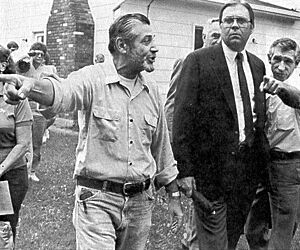
When Eckhardt C. Beck, an EPA Administrator, visited Love Canal in the late 1970s, he saw toxic substances everywhere. He described corroding waste drums breaking through backyards. Trees and gardens were dying. A swimming pool had popped out of its foundation, floating on chemicals. Puddles of harmful substances were in yards, basements, and on school grounds. The air had a faint, choking smell. Children came home from playing with burns on their hands and faces.
Robert Whalen, New York's Health Commissioner, also visited. He believed Love Canal was an emergency. He said it was a serious threat to the health and safety of people living near it. He told people to avoid their basements and not to eat fruits and vegetables from their gardens. Many people were worried because they had eaten produce from their gardens for years. Whalen urged all pregnant women and young children to leave Love Canal as soon as possible.
The 99th Street School was inside the old Hooker Chemical landfill. It was closed two years later and torn down because of leaking toxic waste. However, both the school board and the chemical company denied being responsible for the pollution.
Moving Families and Getting Paid
At first, there was little public interest in Love Canal, which made things harder for the homeowners' association. They also faced opposition from groups trying to prove Hooker Chemical was not careless. Eventually, the federal government moved over 800 families and paid them for their homes. The state and federal governments spent $15 million to buy 400 homes closest to Love Canal and tore down several rows of houses.
In 1994, a judge ruled that Hooker/Occidental had been careless, but not reckless, in handling the waste and selling the land. This decision also included a detailed history of the events. The EPA sued Occidental Petroleum, and in 1995, the company agreed to pay $129 million for cleanup. This money also helped create a small health fund and $3.5 million for a state health study. Lawsuits from residents were also settled in the years after the disaster.
A government report said the sites were successfully cleaned and ready for use again. The Love Canal Area Revitalization Authority sold some abandoned homes to private citizens. Most of the cleanup work was finished by 1989.
The Area Today
Houses on the east and west sides of the canal were torn down. On the west side, only abandoned streets remain. Some older residents on the east side chose to stay, as long as their homes were in a safe area. Fewer than 90 of the original 900 families stayed. On June 4, 1980, the state government created the Love Canal Area Revitalization Agency (LCARA) to fix up the area. LCARA wanted to resell 300 homes that New York had bought when residents moved. These homes are farther from where the chemicals were dumped. The most toxic 16-acre (6.5 ha) area was reburied with a thick plastic liner, clay, and dirt. A 2.4-meter (7.9 ft) high barbed wire fence was put around the area. It's estimated that 248 different chemicals, including 60 kg (130 lb) of dioxin, were found from the canal.
Cleanup Completed
In 2004, federal officials announced that the Superfund cleanup was officially over, though most work had finished years before. The whole process took 21 years and cost $400 million. About 260 homes north of the canal were renovated and sold to new owners. About 150 acres (61 ha) east of the canal were sold to companies for light industrial uses. In total, 950 families were moved out. The site was removed from the Superfund list on September 30, 2004.
After families moved, the canal was buried under a plastic liner, clay, and topsoil in a fenced-off area. Many abandoned homes were also buried. The rest of the Love Canal area was declared safe by the EPA. A public company, the Love Canal Revitalization Agency, took over the abandoned properties. They fixed them up and sold them.
Starting in 1990, 260 homes were given new siding, roofs, and windows, then resold at 20% below market value. They were renamed "Black Creek Village." By 1998, the Love Canal Revitalization Agency had sold 232 of 239 renovated homes. New residents felt safe because the area had been tested a lot. They were attracted by the promise of "cleaned-up land and affordable homes." For example, Dan and Teresa Reynolds bought a 4-bedroom home for less than $40,000 in the early 2000s. They were told the waste was contained and the area was safe.
Former residents who had left Love Canal were worried when new residents started moving in. Luella Kenny's 7-year-old son had died of kidney disease, and a new family later moved into her old home. Kenny noted her son's autopsy showed the "same symptoms they see in animals that have been exposed to dioxin." She worried about the new children, saying, "The children are what bother me when I see them running around this neighborhood. I'm so frightened for them."
In 2013, when Lois Gibbs visited the area again, she was surprised that the containment site no longer had "danger" signs. The signs just said "private property." She noted that someone looking for a house there wouldn't know about the toxins. Gibbs said, "It's like a gated community for chemicals."
By 2013, residents of Black Creek Village complained of mysterious rashes, cysts, and other illnesses, as well as miscarriages. Six families started lawsuits, with notice that 1100 more claims might follow. The lawsuits claimed Love Canal was never properly cleaned and dangerous toxins continued to leak onto properties.
Hooker Chemical Company dumped the chemicals in the 1940s and 1950s. The company was bought by Occidental Petroleum Corporation in 1968. In 1994, to settle a major lawsuit, Occidental agreed to pay New York state $25 million over 30 years. At one point, Occidental's responsibility in the case was estimated to be as much as $700 million. After the settlement in 1995, Occidental was tasked with monitoring the Love Canal site. Occidental gave this responsibility to its subsidiary, Glenn Springs Holdings. The 2013 lawsuits largely tried to hold Occidental responsible. However, the company said the waste was contained, and state and federal agencies supported their position.
In 2024, a New York state court dismissed 18 lawsuits against OxyChem, another Occidental subsidiary. The court found the plaintiffs' claims were "speculative." The plaintiffs have filed an appeal.
Other Contamination: Wheatfield Landfill
As the cleanup of Love Canal began in the 1970s, some contamination was moved elsewhere. Waste equal to 80 dump trucks was dug up and sent to incinerators outside the state. However, some of the waste also ended up less than 10 miles (16 km) away at a landfill owned by the Town of Wheatfield. This landfill was used for city and industrial waste from 1964 to 1968. Residents near the landfill often complained about smells, exposed waste, discolored water, and unsafe conditions, especially for children. In 1965, residents asked the city to fence the area.
In 1968, during the building of the LaSalle Expressway in Niagara Falls, Love Canal waste was dug up and ended up in the Wheatfield landfill. In 1982, a local newspaper first reported that Love Canal waste was in the Wheatfield landfill. Wheatfield officials ignored residents' concerns, but in later years, many residents developed cancers, lupus, and other mysterious illnesses. In 2012, the state Department of Environmental Conservation changed its mind and said the landfill needed cleanup. In 2014, the DEC got Glenn Springs Holdings (Occidental's subsidiary) to pay for removing the Love Canal waste from the Wheatfield landfill. In December 2015, the landfill was declared a Superfund site.
A 2017 lawsuit claims that Hooker's brine pipeline along the edge of the landfill might have created a way for the waste to leak out. Ironically, some residents who lived near the Wheatfield landfill had moved there after being evacuated from their homes in Love Canal.
Images for kids



